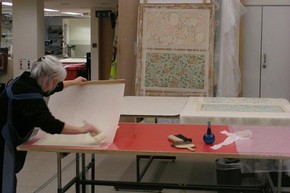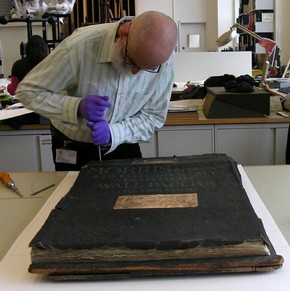Conservation Journal
Spring 2011 Issue 59
Will it stand? Morris and Co. wallpaper stand book
Anne Greig
Book and Paper Conservator
The Morris and Co. stand book was given to the V&A in 1980. It came as part of a large gift of miscellaneous wallpapers, designs and pattern books from the wallpaper manufacturer Shand Kydd Ltd. following the closure of their factory in Christchurch, Hampshire, several years earlier.
A stand book consists of a book block, in this case 132 wallpaper samples each measuring 860 x 498 mm, mounted on a wooden stand. Stand books were an important selling point in a wallpaper manufacturer’s showroom. However, repeated handling, leading to inevitable wear and tear, meant they rarely survived. This particular book is the only intact example of a Morris and Co. stand book as it was used and displayed in a Morris showroom. The book includes a number of machine printed papers, considered inferior products by Morris, alongside the traditional wood-block printed papers he preferred.
Recent research has shown that some early Morris & Co papers were printed with arsenical pigments i.e. Sheele’s green and Scheinfurth green. Due to public concern, Morris & Co. had to find substitutes for this poisonous substance which was gradually phased out. The disclaimer ‘Free from Arsenic’ printed on the cover of the stand book is therefore significant and must have been an important selling point at the time.
What makes this object important? The wallpaper samples contained within the book are important but not unique in themselves, the Museum holds many other examples. It is their place within the book and the printing processes which tell a specific story and make the stand book itself, as a complete object, significant.
Due to its very poor condition the stand book has only been displayed once since its acquisition; as part of the major V&A exhibition William Morris (9 May – 1 September 1996) curated by Linda Parry. For this occasion, the first four wallpaper samples were conserved with Japanese paper and wheat starch paste. However, the Morris & Co stand book has since been chosen as one of the star objects for the Museum’s spring 2011 exhibition The Cult of Beauty: The Aesthetic Movement in Britain 1860-1900. This has prompted a detailed assessment of the book’s condition and an appropriate approach to its overall conservation both for exhibition and future storage and access.
The object was in poor condition, the wooden stand and the samples were too weak to handle and desperately needed to be conserved. When considering conservation treatments, it was important to keep in mind that the stand book would need to be strong enough to be displayed as it would have originally in the Morris and Co. showroom. The strength and appearance of the wooden stand and wallpaper samples after conservation were the main concerns, along with future access.
The stand book is bound together with nails, screws and glue along the spine edge. The front cover is made from a thick black oilcloth, which is torn along the edges, has many losses and its oil painted lettering is cracked and flaking. The wooden support is weak, broken in places and held together with string. The front cover and wallpaper samples are dirty, with both loose and ingrained dirt. There is evidence of water damage, with water and pigments stains found throughout the book. The wallpaper samples are torn, creased and stained with many losses and the handling edges are weak, dirty and worn. The samples have previously been repaired in an ad hoc fashion with: brown paper, pressure sensitive tape (i.e. sellotape) and gummed stamp, which have caused distortions and stains. The paper supports are of differing quality, and due to deterioration show signs of discoloration, in some cases quite dark in colour and very fibrous. The media on most of the samples is thick, friable and fugitive. Overall, the samples could not be handled or the pages turned safely without the risk of further damage.
Health and safety issues had to be addressed before any conservation work could begin. An analysis of the wallpaper pigments was carried out by Dr. Lucia Burgio (Senior Object Anlaysis Scientist) to check if any arsenical pigments were present. As the disclaimer on the front cover of the stand book confirms, no trace of arsenic was found.
In order to repair and consolidate each wallpaper sample the book first had to be dismantled; this was carried out with the help of Nigel Bamforth (Senior Furniture Conservator). The wooden stand has since been conserved separately by Dana Melchar (Senior Furniture Conservator). The time available for conservation of the wallpaper samples was limited and after lengthy discussion it was agreed to line each individual sample with Japanese paper, once any old repairs had been removed. This was considered the best option as each sample would be treated the same, giving the book some uniformity. Also, as wallpaper samples in showrooms were often lined with calico or cloth, this decision would not be seen as an anomaly. The lining of each object will unfortunately increase the bulk of the sample book, but the lightness of the paper should keep this to a minimum.
The next consideration was which Japanese paper to use. Strength, dimensional stability, flexibility, colour, transparency and lightness were seen as essential factors, but as 132 wallpaper samples had to be lined cost also became an important factor. After testing four different types of Japanese paper, it was found that Sekushi light from Masumi Corporation matched most of the essential factors. Also, as the sheet size fitted the dimensions of the samples no trimming would be required, The transparency of the paper also allows the printed name and price on the verso of each sample to be read easily.

Figure 2 - Lining and drying William Morris wallpaper samples on karibari board. Photograph by Sophie Connor, November 2010
During testing it was discovered that the samples stained easily when treated with water. Humidification on Gore-tex® was therefore seen as essential in order to avoid staining, as this method is controllable. Once they had been lined, the samples are dried under tension on a Karibari board for two weeks.
Not until all the samples have been lined and the whole object reassembled will we know how strong the stand book will be and how much extra support might be necessary. Once fully conserved and reassembled the stand book can sit proudly on display as it once did in the showroom of Morris & Co.
Bibliography
Web 04/10/2010
http://www.popularscience.co.uk/features/feat17.htm
http://www.backspace.com/notes/2003/06/this-wallpaper-is-killing-me.php
Acknowledgments
Thank you for help and assistance to Mike Wheeler (Senior Paper Conservator) and Gill Saunders (Senior Curator)
Spring 2011 Issue 59
- Editorial
- Keep Your Hair On - The development of conservation friendly wigs
- ‘X’ Marks the Spot: The conservation and correction of a Carlo Bugatti Chair
- Removing and re-attaching paper labels
- Will it stand? Morris and Co. wallpaper stand book
- Melting pot: Conserving wax objects in textile conservation
- The effects of fingerprints on silver
- The conservation of John Constable’s six foot sketches at the V&A
- The show must go on: Touring textile and costume objects with hazardous substances
- Dust to dust. Access to access.
- An update on lasers in sculpture conservation
- An approach to conserving study collections
- I’m always touched (by your presence dear)
- The contemporary art of documentation
- The Popart project
- V&A launches new National Conservation Diploma and the Conservator Development Programme
- Editorial board & Disclaimer
- Printer friendly version
